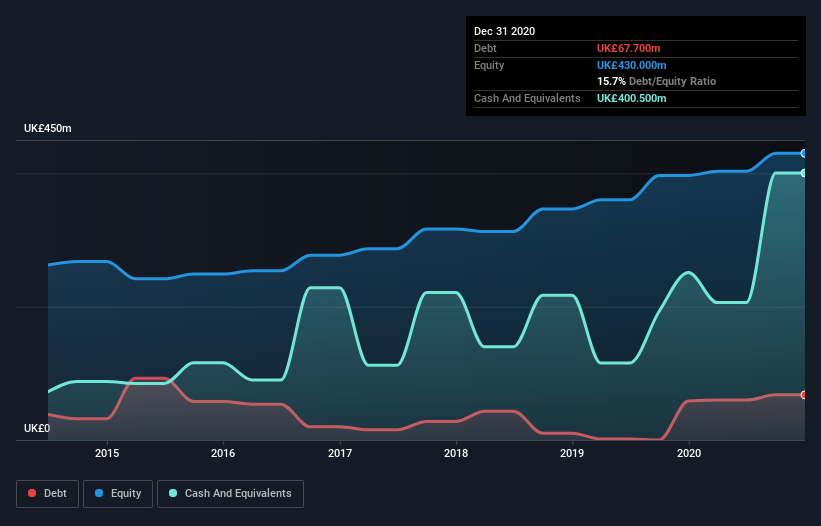These 4 Measures Indicate That Morgan Sindall Group (LON:MGNS) Is Using Debt Reasonably Well
David Iben put it well when he said, 'Volatility is not a risk we care about. What we care about is avoiding the permanent loss of capital.' So it seems the smart money knows that debt - which is usually involved in bankruptcies - is a very important factor, when you assess how risky a company is. As with many other companies Morgan Sindall Group plc (LON:MGNS) makes use of debt. But is this debt a concern to shareholders?
When Is Debt Dangerous?
Generally speaking, debt only becomes a real problem when a company can't easily pay it off, either by raising capital or with its own cash flow. Part and parcel of capitalism is the process of 'creative destruction' where failed businesses are mercilessly liquidated by their bankers. However, a more common (but still painful) scenario is that it has to raise new equity capital at a low price, thus permanently diluting shareholders. Of course, plenty of companies use debt to fund growth, without any negative consequences. The first step when considering a company's debt levels is to consider its cash and debt together.
View our latest analysis for Morgan Sindall Group
What Is Morgan Sindall Group's Debt?
The image below, which you can click on for greater detail, shows that at December 2020 Morgan Sindall Group had debt of UK£67.7m, up from UK£58.5m in one year. But it also has UK£400.5m in cash to offset that, meaning it has UK£332.8m net cash.
How Strong Is Morgan Sindall Group's Balance Sheet?
We can see from the most recent balance sheet that Morgan Sindall Group had liabilities of UK£978.9m falling due within a year, and liabilities of UK£79.7m due beyond that. Offsetting this, it had UK£400.5m in cash and UK£395.1m in receivables that were due within 12 months. So it has liabilities totalling UK£263.0m more than its cash and near-term receivables, combined.
This deficit isn't so bad because Morgan Sindall Group is worth UK£1.02b, and thus could probably raise enough capital to shore up its balance sheet, if the need arose. However, it is still worthwhile taking a close look at its ability to pay off debt. Despite its noteworthy liabilities, Morgan Sindall Group boasts net cash, so it's fair to say it does not have a heavy debt load!
It is just as well that Morgan Sindall Group's load is not too heavy, because its EBIT was down 29% over the last year. When a company sees its earnings tank, it can sometimes find its relationships with its lenders turn sour. When analysing debt levels, the balance sheet is the obvious place to start. But it is future earnings, more than anything, that will determine Morgan Sindall Group's ability to maintain a healthy balance sheet going forward. So if you're focused on the future you can check out this free report showing analyst profit forecasts.
Finally, a company can only pay off debt with cold hard cash, not accounting profits. Morgan Sindall Group may have net cash on the balance sheet, but it is still interesting to look at how well the business converts its earnings before interest and tax (EBIT) to free cash flow, because that will influence both its need for, and its capacity to manage debt. Over the last three years, Morgan Sindall Group actually produced more free cash flow than EBIT. That sort of strong cash generation warms our hearts like a puppy in a bumblebee suit.
Summing up
Although Morgan Sindall Group's balance sheet isn't particularly strong, due to the total liabilities, it is clearly positive to see that it has net cash of UK£332.8m. The cherry on top was that in converted 120% of that EBIT to free cash flow, bringing in UK£172m. So we don't have any problem with Morgan Sindall Group's use of debt. When analysing debt levels, the balance sheet is the obvious place to start. However, not all investment risk resides within the balance sheet - far from it. For example, we've discovered 4 warning signs for Morgan Sindall Group that you should be aware of before investing here.
At the end of the day, it's often better to focus on companies that are free from net debt. You can access our special list of such companies (all with a track record of profit growth). It's free.
This article by Simply Wall St is general in nature. It does not constitute a recommendation to buy or sell any stock, and does not take account of your objectives, or your financial situation. We aim to bring you long-term focused analysis driven by fundamental data. Note that our analysis may not factor in the latest price-sensitive company announcements or qualitative material. Simply Wall St has no position in any stocks mentioned.
Have feedback on this article? Concerned about the content? Get in touch with us directly. Alternatively, email editorial-team (at) simplywallst.com.

 Yahoo Finance
Yahoo Finance 
